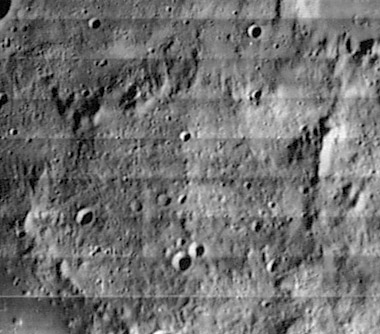Birmingham
Contents
Birmingham
|
Lat: 65.1°N, Long: 10.5°W, Diam: 92 km, Depth: 0.83 km, [/R%C3%BCkl%204 Rükl: 4], [/Stratigraphy pre-Nectarian] |
Table of Contents

Lunar Orbiter 4-128 h2
Images
LPOD Photo Gallery Lunar Orbiter Images
Maps
([/LAC%20zone LAC zone] 3C4) USGS Digital Atlas PDF
Description
Description: Elger
([/IAU%20Directions IAU Directions]) BIRMINGHAM.-- A large rhomboidal-shaped enclosure, defined by mountain chains and traversed by a number of very remarkable parallel ridges. It is situated nearly due N. of [/Plato Plato] on the N. edge of the [/Mare%20Frigoris Mare Frigoris], and lies on the S.W. side of [/W.%20Bond W.C. Bond], to which it bears a certain resemblance. This region is characterised by the parallelism displayed by many formations, large and small. It is more apparent hereabouts than in any other part of the moon's visible surface. When favourably placed under a low morning sun, Birmingham is a striking telescopic object.
Description: Wikipedia
Additional Information
Depth data from [/Kurt%20Fisher%20crater%20depths Kurt Fisher database]
- Westfall, 2000: 0.83 km
- Cherrington, 1969: 1.7 km
Central peak height
- [/Sekiguchi%2C%201972 Sekiguchi, 1972]: 0.3 km
Other interior peak heights
- 0.2 km: "A peak standing on the south of a small crater, Birmingham G." - [/Sekiguchi%2C%201972 Sekiguchi, 1972]
- 0.2 km: "An oblong hill at the south-westerly part of the floor" - [/Sekiguchi%2C%201972 Sekiguchi, 1972]
Nomenclature
- Named for John Birmingham (1814 - 1884) of Millbrook, County Galway, Ireland, an amateur astronomer who discovered the nova T Coronae Borealis (1866). He published a catalogue of red, variable stars and wrote a variety of astronomy articles. (Source: Paul Mohr)
- Other features named after [/Ireland Irish scientists].
- Several hills southwest of Birmingham (at the northern section of Mare Frigoris) received Greek letter designations, see charts 2 and 3 in the Times Atlas of the Moon, and also SLC-section D1. Are some of those hills, or perhaps all of them, part of the formation which was once called Madler's square?
LPOD Articles
Bibliography
- Mohr, P. 1997. John Birmingham on "A Crater in the Moon". Irish Astronomical Journal, 24(1), p. 59.
- Mohr, P. (1995) Tuam, Rome and Berlin - Letters from John Birmingham - Irish Astronomical Journal, 22(2), 203, 1995.
This page has been edited 1 times. The last modification was made by - tychocrater tychocrater on Jun 13, 2009 3:24 pm - afx3u2